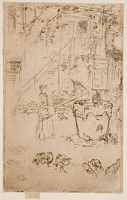Etchings Institutions search term: caxton club
Turkeys | ||
| Number: | 236 | |
| Date: | 1880 | |
| Medium: | etching and drypoint | |
| Size: | 209 x 135 mm | |
| Signed: | butterfly at lower left (2) | |
| Inscribed: | no | |
| Set/Publication: | 'Second Venice Set', 1886 | |
| No. of States: | 2 | |
| Known impressions: | 42 | |
| Catalogues: | K.199; M.196; W.165 | |
| Impressions taken from this plate (42) | ||
PUBLICATION
Whistler delivered in all 1093 prints and was paid £2.10.6 for printing each dozen prints. 13
13: Dowdeswell to Whistler, invoice 16 July 1887, GUW #00891.
EXHIBITIONS
The Saturday Review responded with its own brand of humour :
14: London FAS 1883 (cat. no. 7).
15: 'Mr Whistler's Exhibition', Saturday Review, 24 February 1883 (GUL PC 25/32).
16: Anon., 'The Whistler Exhibition', New York Mail and Express, 24 October 1883 (GUL PC3/61, PC4/12).
An impression was shown at the New York Etching Club show at the National Academy of Design in 1889. Bryan Lathrop (1844-1916) lent one to a show organised by the Caxton Club in Chicago in 1900 (
 ). 18 An impression was included in a large group of etchings lent by James Cox-Cox (ca 1849- d.1901) to the Glasgow International Exhibition in 1901. 19
). 18 An impression was included in a large group of etchings lent by James Cox-Cox (ca 1849- d.1901) to the Glasgow International Exhibition in 1901. 19
After Whistler's death, it was shown in the Memorial Exhibitions in New York, Boston, Paris and London. Henry Studdy Theobald (1847-1934) lent an impression to the Whistler Memorial Show in London in 1905. 20
17: New York 1898 ; New York 1903b (cat. no. 128); London Obach 1903 (cat. nos. 141, 142)
18: Chicago 1900 (cat. no. 145). See REFERENCES : EXHIBITIONS.
19: Glasgow 1901 (cat. no. 216).
20: New York 1904a (cat. no. 165); London Mem. 1905 (cat. no. 165).
SALES & COLLECTORS
Most sales were made by the publishers Messrs Dowdeswell after 1886. However, Whistler was also allowed to give away or sell the proofs of new states, and apparently gave one impression of the second state to George Moore (1852-1933); it has not been located. 22
Among the later sales, another London print dealer, Robert Dunthorne (b. ca 1851), bought one impression from Whistler, for £10.10.0 in December 1902, possibly for a Christmas present, and another - presumably a choice one - for £14.14.0, in June 1903, just before the artist's death. 23
At auction, impressions brought much lower prices, and were bought mainly by print dealers. One fetched only £1.1.0 in 1888; then, at the 1892 sale of the collection of the late Joshua Hutchinson Hutchinson (ca 1829 - d.1891), another - a second state - fetched £2.2.0 (
 ). By comparison, a complete second Venice set, from the collection of Mrs Edward Fisher, fetched £82.0.0 in 1897. 24
). By comparison, a complete second Venice set, from the collection of Mrs Edward Fisher, fetched £82.0.0 in 1897. 24
21: 28 August 1882, GUW #13643; [23 June 1884], GUW #01175; September 1897, GUW #07287.
22: Catalogue of Etchings, Drypoints, Wood Engravings and Lithographs, Anderson Galleries, [New York], 10 April 1919, priced $975.
23: 24 December 1902, GUW #13040; 17 June 1903, #13042.
24: Christie's, 27 November 1888 (lot 164), bought by Gustave Lauser (b. ca 1841); Sotheby's, 3 March 1892 (lot 260), bought 'Blunt'; Christie's, 13-14 July 1897 (lot 316), bought by Colnaghi's.
 ); Ernest Stephen Lumsden (1883-1968) (
); Ernest Stephen Lumsden (1883-1968) ( ); Otto Gerstenberg (1848-1935) (
); Otto Gerstenberg (1848-1935) ( ) and Atherton Curtis (1863-1944) (
) and Atherton Curtis (1863-1944) ( ). Several impressions were bequeathed by Whistler to his siter-in-law Rosalind Birnie Philip (1873-1958) and passed by her to the University of Glasgow (
). Several impressions were bequeathed by Whistler to his siter-in-law Rosalind Birnie Philip (1873-1958) and passed by her to the University of Glasgow ( ,
,  ,
,  ,
,  ).
).  ) but the impressions owned by Albert W. Scholle (1860-1917) and Henry Harper Benedict (1844-1935) have not been identified. Other American collectors included Samuel Putnam Avery (1822-1904) (
) but the impressions owned by Albert W. Scholle (1860-1917) and Henry Harper Benedict (1844-1935) have not been identified. Other American collectors included Samuel Putnam Avery (1822-1904) ( ); Charles Lang Freer (1856-1919), who bought one from F. Keppel & Co. in 1887 (
); Charles Lang Freer (1856-1919), who bought one from F. Keppel & Co. in 1887 ( ) and another from E. G. Deprez in 1905 (
) and another from E. G. Deprez in 1905 ( ); George Aloysius Lucas (1824-1909) (
); George Aloysius Lucas (1824-1909) ( ); Isabella Stewart Gardner (1840-1924), who bought it as part of a complete set from Wunderlich's (
); Isabella Stewart Gardner (1840-1924), who bought it as part of a complete set from Wunderlich's ( ); Howard Mansfield (1849-1938) (
); Howard Mansfield (1849-1938) ( ); Bryan Lathrop (1844-1916) (
); Bryan Lathrop (1844-1916) ( ); Harry Brisbane Dick (1855-1916) (
); Harry Brisbane Dick (1855-1916) ( ); Charles Deering (1852-1927) (
); Charles Deering (1852-1927) ( ); Ralph King (1855-1926) (
); Ralph King (1855-1926) ( ); and Walter Stanton Brewster (1872-1954) (
); and Walter Stanton Brewster (1872-1954) ( ,
,  ).
).25: Mansfield 1909 (cat. no. 196).
